Free-Standing Complementary Asymmetric Metasurface for Terahertz Sensing Applications †
Abstract
1. Introduction
2. Materials and Methods
3. Sensor Performance Evaluation
4. Conclusions
Author Contributions
Funding
Conflicts of Interest
References
- Pendry, J.B.; Holden, A.J.; Robbins, D.J.; Stewart, W.J. Magnetism from Conductors and Enhanced Nonlinear Phenomena. IEEE Trans. Microw. Theory Tech. 1999, 47, 2075–2084. [Google Scholar] [CrossRef]
- Zheludev, N.I.; Prosvirnin, S.L.; Papasimakis, N.; Fedotov, V.A. Lasing spaser. Nat. Photonics 2008, 2, 351–354. [Google Scholar] [CrossRef]
- Driscoll, T.; Andreev, G.O.; Basov, D.N.; Palit, S.; Cho, S.Y.; Jokerst, N.M.; Smith, D.R. Tuned permeability in terahertz split-ring resonators for devices and sensors. Appl. Phys. Lett. 2007, 91, 1–4. [Google Scholar] [CrossRef]
- Elhawil, A.; Stiens, J.; De Tandt, C.; Ranson, W.; Vounckx, R. Thin-film sensing using circular split-ring resonators at mm-wave frequencies. Appl. Phys. A 2011, 103, 623–626. [Google Scholar] [CrossRef]
- Al-Naib, I.A.I.; Jansen, C.; Koch, M. Thin-film sensing with planar asymmetric metamaterial resonators. Appl. Phys. Lett. 2008, 93, 91–94. [Google Scholar] [CrossRef]
- Xu, Z.; Lin, Z.; Cheng, S.; Lin, Y.-S. Reconfigurable and tunable terahertz wrench-shape metamaterial performing programmable characteristic. Opt. Lett. 2019, 44, 3944. [Google Scholar] [CrossRef] [PubMed]
- Manjappa, M.; Pitchappa, P.; Singh, N.; Wang, N.; Zheludev, N.I.; Lee, C.; Singh, R. Reconfigurable MEMS Fano metasurfaces with multiple-input–output states for logic operations at terahertz frequencies. Nat. Commun. 2018, 9, 1–10. [Google Scholar] [CrossRef]
- Ren, Z.; Chang, Y.; Ma, Y.; Shih, K.; Dong, B.; Lee, C. Leveraging of MEMS Technologies for Optical Metamaterials Applications. Adv. Opt. Mater. 2020, 8, 1–20. [Google Scholar] [CrossRef]
- Liu, P.; Liang, Z.; Lin, Z.; Xu, Z.; Xu, R.; Yao, D.; Lin, Y.S. Actively tunable terahertz chain-link metamaterial with bidirectional polarization-dependent characteristic. Sci. Rep. 2019, 9, 1–8. [Google Scholar] [CrossRef]
- Lee, C.R.; Lin, S.H.; Wang, S.M.; Lin, J.D.; Chen, Y.S.; Hsu, M.C.; Liu, J.K.; Mo, T.S.; Huang, C.Y. Optically controllable photonic crystals and passively tunable terahertz metamaterials using dye-doped liquid crystal cells. J. Mater. Chem. C 2018, 6, 4959–4966. [Google Scholar] [CrossRef]
- Chen, H.T.; O’Hara, J.F.; Azad, A.K.; Taylor, A.J. Manipulation of terahertz radiation using metamaterials. Laser Photonics Rev. 2011, 5, 513–533. [Google Scholar] [CrossRef]
- Zheludev, N.I.; Kivshar, Y.S. From metamaterials to metadevices. Nat. Mater. 2012, 11, 917–924. [Google Scholar] [CrossRef] [PubMed]
- Soukoulis, C.M.; Kafesaki, M.; Economou, E.N. Negative-index materials: New frontiers in optics. Adv. Mater. 2006, 18, 1941–1952. [Google Scholar] [CrossRef]
- Smith, D.R.; Pendry, J.B.; Wiltshire, M.C.K. Metamaterials and Negative Refractive Index. Science 2004, 305, 788–793. [Google Scholar] [CrossRef] [PubMed]
- Anantha Ramakrishna, S. Physics of negative refractive index materials. Rep. Prog. Phys. 2005, 68, 449–521. [Google Scholar] [CrossRef]
- Soukoulis, C.M.; Linden, S.; Wegener, M. Negative refractive index at optical wavelengths. Science 2007, 315, 47–49. [Google Scholar] [CrossRef]
- Cai, W.; Chettiar, U.K.; Kildishev, A.V.; Shalaev, V.M. Optical cloaking with metamaterials. Nat. Photonics 2007, 1, 224. [Google Scholar] [CrossRef]
- Aydin, K.; Bulu, I.; Ozbay, E. Subwavelength resolution with a negative-index metamaterial super lens. Appl. Phys. Lett. 2007, 90, 1–4. [Google Scholar] [CrossRef]
- Born, N.; Reuter, M.; Koch, M.; Scheller, M. High-Q terahertz bandpass filters based on coherently interfering metasurface reflections. Opt. Lett. 2013, 38, 908. [Google Scholar] [CrossRef]
- O’Hara, J.F.; Withayachumnankul, W.; Al-Naib, I. A review on thin-film sensing with terahertz waves. J. Infrared. Millim. Terahertz Waves 2012, 33, 245–291. [Google Scholar] [CrossRef]
- Gupta, M.; Singh, R. Toroidal versus Fano Resonances in High Q planar THz Metamaterials. Adv. Opt. Mater. 2016, 4, 2119–2125. [Google Scholar] [CrossRef]
- Park, S.J.; Hong, J.T.; Choi, S.J.; Kim, H.S.; Park, W.K.; Han, S.T.; Park, J.Y.; Lee, S.; Kim, D.S.; Ahn, Y.H. Detection of microorganisms using terahertz metamaterials. Sci. Rep. 2014, 4, 1–7. [Google Scholar] [CrossRef] [PubMed]
- Kiwa, T.; Kondo, Y.; Minami, Y.; Kawayama, I.; Tonouchi, M.; Tsukada, K. Terahertz chemical microscope for label-free detection of protein complex. Appl. Phys. Lett. 2010, 96, 1–4. [Google Scholar] [CrossRef]
- Upadhya, P.C.; Shen, Y.C.; Davies, A.G.; Linfield, E.H. Terahertz Time-Domain Spectroscopy of Glucose and Uric Acid. J. Biol. Phys. 2003, 29, 117–121. [Google Scholar] [CrossRef] [PubMed]
- Roh, Y.; Lee, S.-H.; Kang, B.; Wu, J.W.; Ju, B.-K.; Seo, M. Terahertz optical characteristics of two types of metamaterials for molecule sensing. Opt. Express 2019, 27, 19042. [Google Scholar] [CrossRef] [PubMed]
- Lee, D.K.; Kang, J.H.; Lee, J.S.; Kim, H.S.; Kim, C.; Hun Kim, J.; Lee, T.; Son, J.H.; Park, Q.H.; Seo, M. Highly sensitive and selective sugar detection by terahertz nano-antennas. Sci. Rep. 2015, 5, 1–7. [Google Scholar] [CrossRef]
- Lee, D.K.; Kang, J.H.; Kwon, J.; Lee, J.S.; Lee, S.; Woo, D.H.; Kim, J.H.; Song, C.S.; Park, Q.H.; Seo, M. Nano metamaterials for ultrasensitive Terahertz biosensing. Sci. Rep. 2017, 7, 5–10. [Google Scholar] [CrossRef]
- Al-Naib, I. Biomedical Sensing with Conductively Coupled Terahertz Metamaterial Resonators. IEEE J. Sel. Top. Quantum Electron. 2017, 23, 1–5. [Google Scholar] [CrossRef]
- Al-Naib, I. Evaluation of amplitude difference referencing technique with terahertz metasurfaces for sub-micron analytes sensing. J. King Saud Univ.-Sci. 2018, 31, 1384–1387. [Google Scholar] [CrossRef]
- Singh, R.; Cao, W.; Al-Naib, I.; Cong, L.; Withayachumnankul, W.; Zhang, W. Ultrasensitive terahertz sensing with high-Q Fano resonances in metasurfaces. Appl. Phys. Lett. 2014, 105, 171001. [Google Scholar] [CrossRef]
- Cong, L.; Tan, S.; Yahiaoui, R.; Yan, F.; Zhang, W.; Singh, R. Experimental demonstration of ultrasensitive sensing with terahertz metamaterial absorbers: A comparison with the metasurfaces. Appl. Phys. Lett. 2015, 106, 031107. [Google Scholar] [CrossRef]
- Chiang, W.-F.; Hsieh, Y.-T.; Wang, S.-H.; Miao, H.-Y.; Liu, J.-H.; Huang, C.-Y. Effect of swelling of a photoresist on electromagnetic resonance of terahertz metamaterials. Opt. Lett. 2016, 41, 2879–2882. [Google Scholar] [CrossRef] [PubMed]
- Averitt, D.; Tao, H.; Strikwerda, A.C.; Fan, K.; Bingham, C.M.; Padilla, W.J. Terahertz metamaterials on free-standing highly-flexible polyimide substrates. J. Phys. D Appl. Phys. 2008, 41, 232004. [Google Scholar]
- Peralta, X.G.; Wanke, M.C.; Arrington, C.L.; Williams, J.D.; Brener, I.; Strikwerda, A.; Averitt, R.D.; Padilla, W.J.; Smirnova, E.; Taylor, A.J.; et al. Large-area metamaterials on thin membranes for multilayer and curved applications at terahertz and higher frequencies. Appl. Phys. Lett. 2009, 94, 1–4. [Google Scholar] [CrossRef]
- Hara, J.F.O.; Singh, R.; Brener, I.; Smirnova, E.; Han, J.; Taylor, A.J.; Zhang, W. Thin-film sensing with planar terahertz metamaterials: Sensitivity and limitations Abstract. Opt. Express 2008, 16, 1786–1795. [Google Scholar] [CrossRef]
- Withayachumnankul, W.; Hara, J.F.O.; Cao, W.; Al-Naib, I.; Zhang, W. Limitation in thin-film sensing with transmission-mode terahertz time-domain spectroscopy. Opt. Express 2014, 22, 1075–1080. [Google Scholar] [CrossRef]
- Tao, H.; Strikwerda, A.C.; Liu, M.; Mondia, J.P.; Ekmekci, E.; Fan, K.; Kaplan, D.L.; Padilla, W.J.; Zhang, X.; Averitt, R.D.; et al. Performance enhancement of terahertz metamaterials on ultrathin substrates for sensing applications. Appl. Phys. Lett. 2010, 97, 1–4. [Google Scholar] [CrossRef]
- Chiam, S.Y.; Singh, R.; Zhang, W.; Bettiol, A.A. Controlling metamaterial resonances via dielectric and aspect ratio effects. Appl. Phys. Lett. 2010, 97, 191906. [Google Scholar] [CrossRef]
- Fedotov, V.A.; Rose, M.; Prosvirnin, S.L.; Papasimakis, N.; Zheludev, N.I. Sharp Trapped-Mode Resonances in Planar Metamaterials with a Broken Structural Symmetry. Phys. Rev. Lett. 2007, 147401, 5–8. [Google Scholar] [CrossRef]
- Singh, R.; Al-Naib, I.A.I.; Koch, M.; Zhang, W. Sharp Fano resonances in THz metamaterials. Opt. Express 2011, 19, 6312–6319. [Google Scholar] [CrossRef]
- Al-Naib, I.A.I.; Jansen, C.; Koch, M. High Q -factor metasurfaces based on miniaturized asymmetric single split resonators. Appl. Phys. Lett. 2009, 94, 1–4. [Google Scholar] [CrossRef]
- Hao, F.; Sonnefraud, Y.; Dorpe, P.V.; Maier, S.A.; Halas, N.J.; Nordlander, P. Symmetry Breaking in Plasmonic Nanocavities: Subradiant LSPR Sensing and a Tunable Fano Resonance. Nano Lett. 2008, 8, 3983–3988. [Google Scholar] [CrossRef] [PubMed]
- Li, Z.; Cakmakyapan, S.; Butun, B.; Daskalaki, C.; Tzortzakis, S.; Yang, X.; Ozbay, E. Fano resonances in THz metamaterials composed of continuous metallic wires and split ring resonators. Opt. Express 2014, 22, 1663–1667. [Google Scholar] [CrossRef] [PubMed]
- Fan, S. Sharp asymmetric line shapes in side-coupled waveguide-cavity systems. Appl. Phys. Lett. 2002, 80, 908–910. [Google Scholar] [CrossRef]
- Cao, W.; Singh, R.; Al-Naib, I.A.I.; He, M.; Taylor, A.J.; Zhang, W. Low-loss ultra-high-Q dark mode plasmonic Fano metamaterials. Opt. Lett. 2012, 37, 3366. [Google Scholar] [CrossRef] [PubMed]
- Al-Naib, I.A.I.; Jansen, C.; Born, N.; Koch, M. Polarization and angle independent terahertz metamaterials with high Q-factors. Appl. Phys. Lett. 2011, 98, 15–18. [Google Scholar] [CrossRef]
- Born, N.; Balzer, J.C.; Gente, R.; Al-Naib, I.; Koch, M. Laser beam machined freestanding terahertz metamaterials. Electron. Lett. 2015, 51, 1012–1014. [Google Scholar] [CrossRef]
- De Smet, E.; Rioux, J.P.; Ammann, H.; Déziel, C.; Quérin, S. FSGS permeability factor-associated nephrotic syndrome: Remission after oral galactose therapy. Nephrol. Dial. Transpl. 2009, 24, 2938–2940. [Google Scholar] [CrossRef]
- Taleb, F.; Al-Naib, I.; Koch, M. Terahertz Metamaterials based on Free-standing Complementary Asymmetric Split Ring Resonators for Sensing Applications. In Proceedings of the 44th International Conference on Infrared, Millimeter, and Terahertz Waves (IRMMW-THz), Paris, France, 1–6 September 2019; pp. 1–2. [Google Scholar]
- CST Studio Suite 3D EM Simulation and Analysis Software. Available online: https://www.3ds.com/products-services/simulia/products/cst-studio-suite/ (accessed on 15 April 2020).
- Vieweg, N.; Rettich, F.; Deninger, A.; Roehle, H.; Dietz, R.; Schell, M. Terahertz-time domain spectrometer with 90 dB peak dynamic range. J. Infrared Millim. Terahertz Waves 2014, 35, 823–832. [Google Scholar] [CrossRef]
- Hunsche, S.; Mittleman, D.M.; Koch, M.; Nuss, M.C. New Dimensions in T-Ray Imaging. Ieice Trans. Electron. 1998, E81–C, 269–276. [Google Scholar]
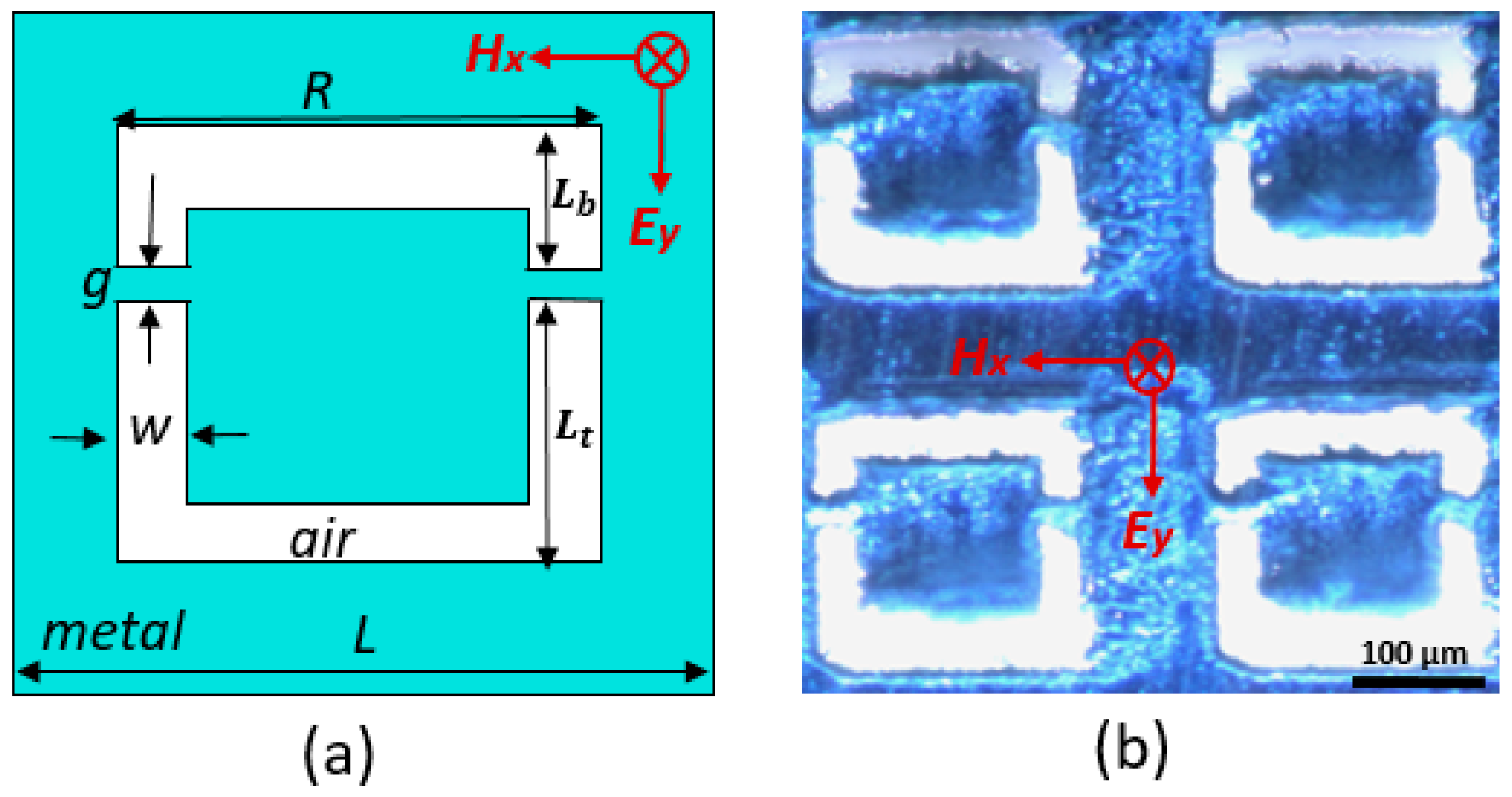
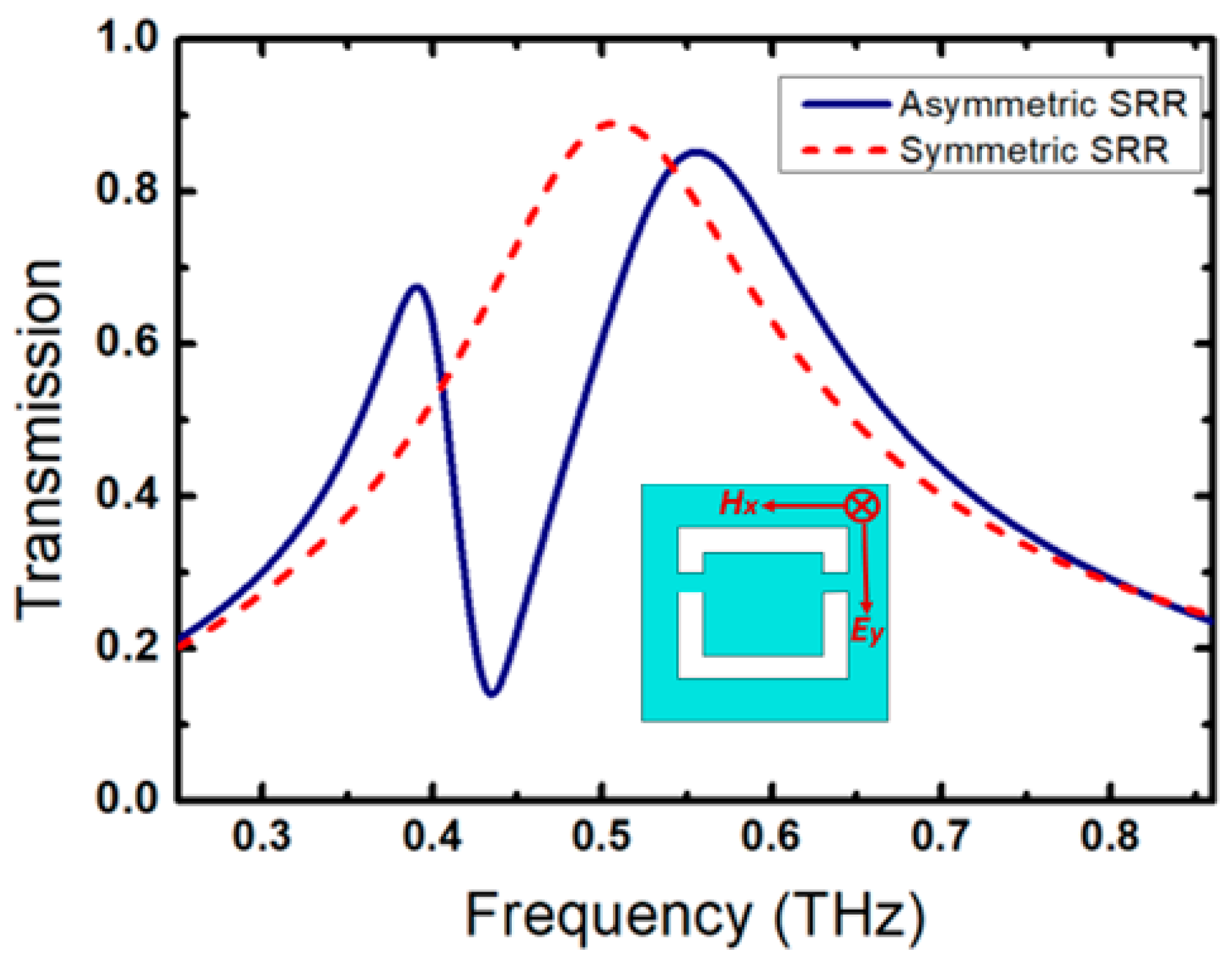
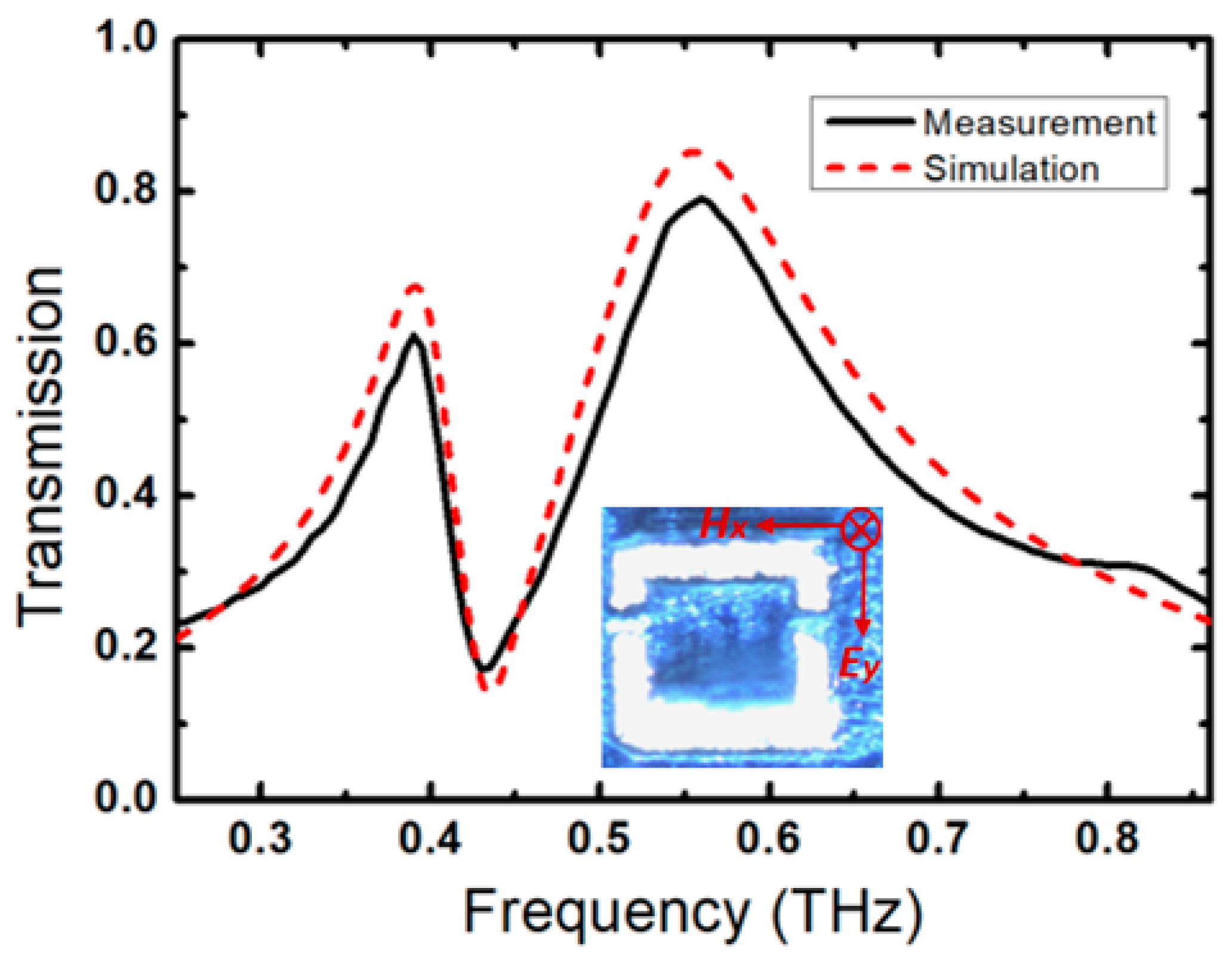
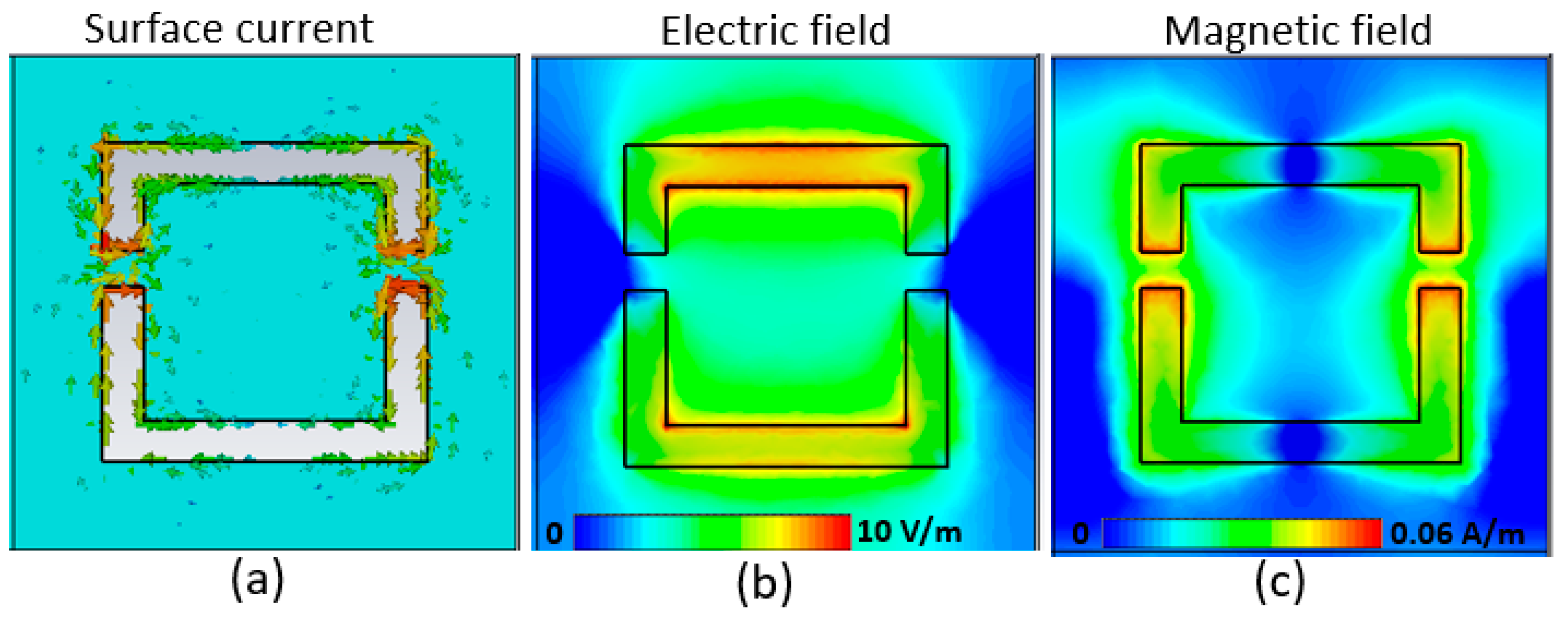
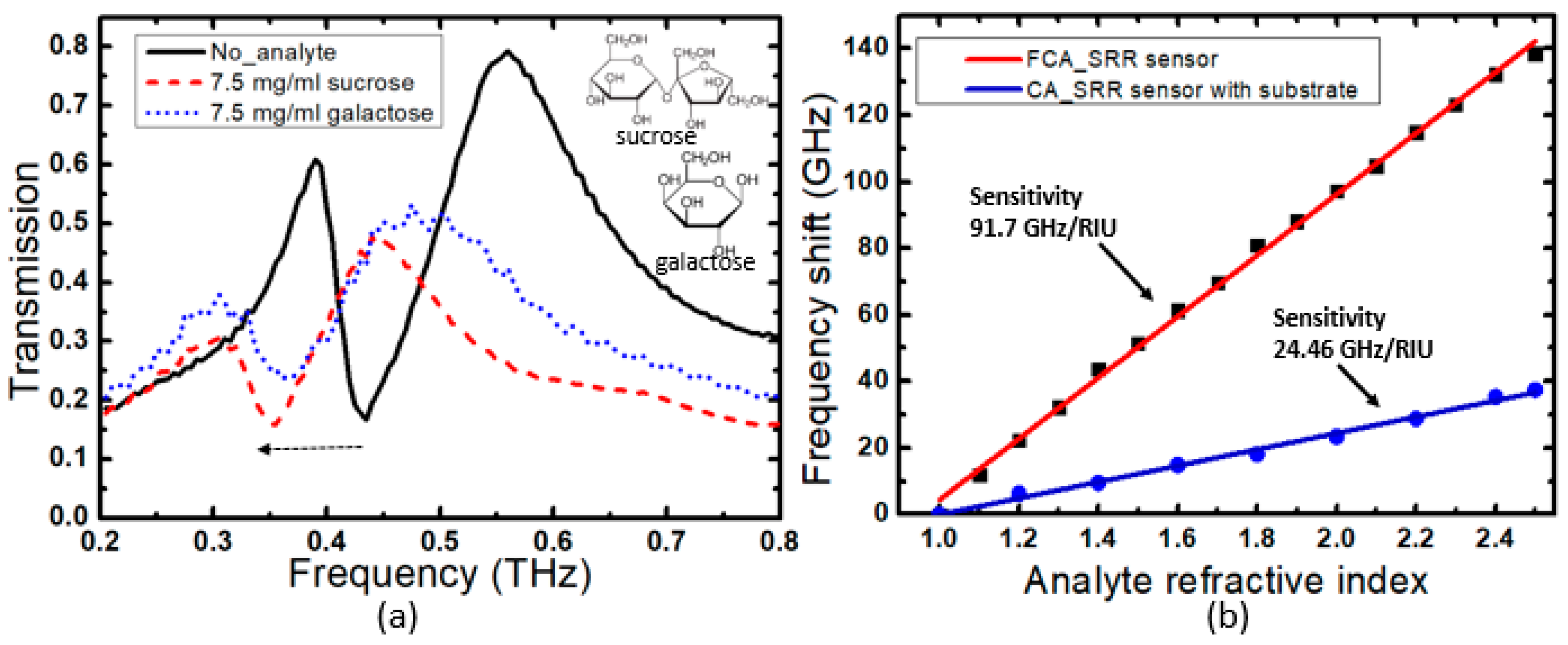
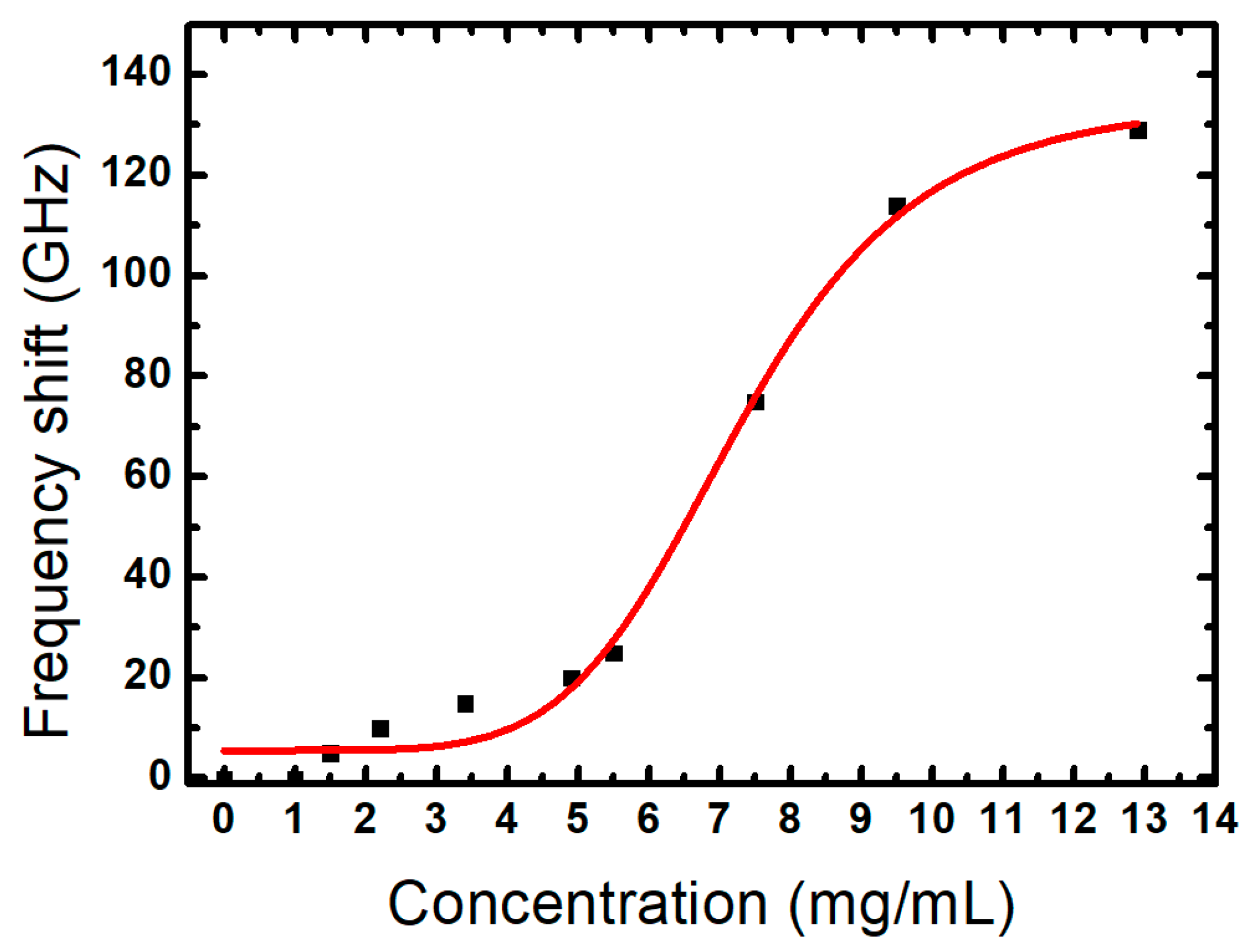
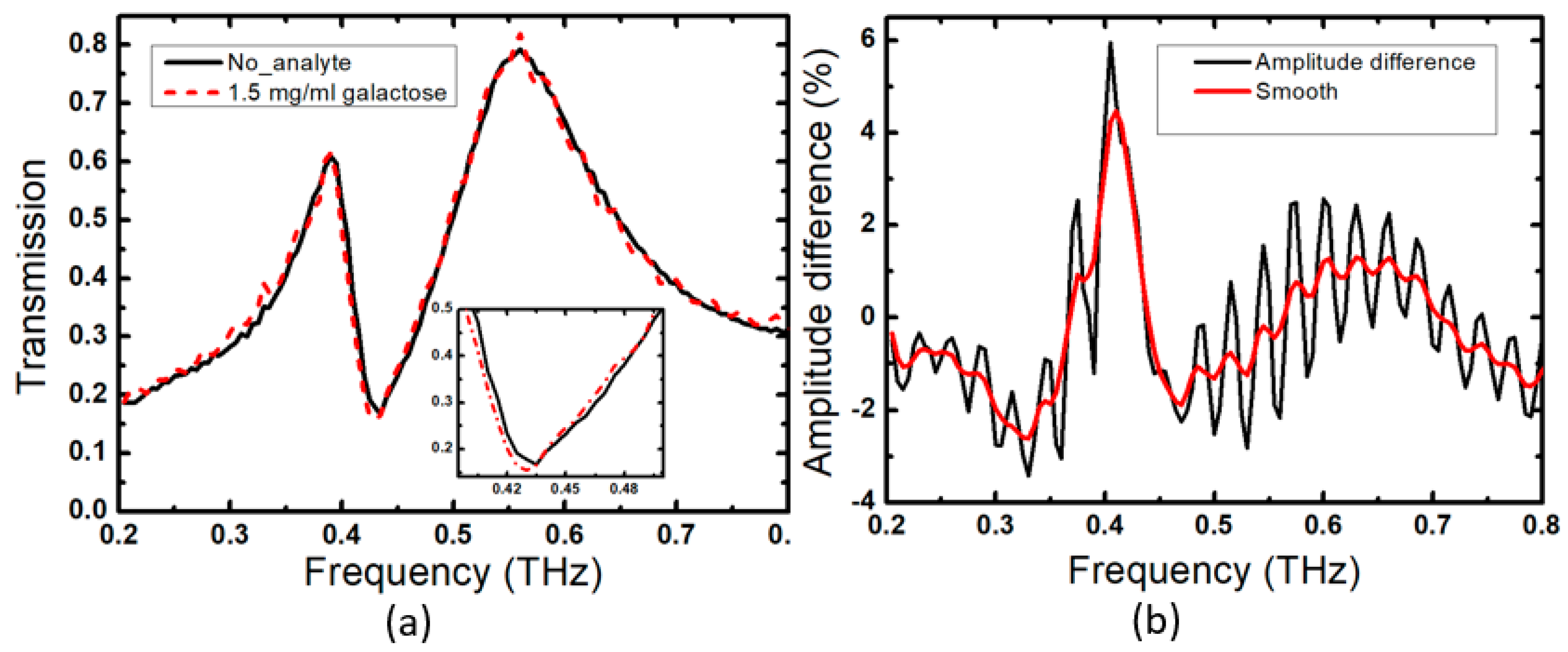
© 2020 by the authors. Licensee MDPI, Basel, Switzerland. This article is an open access article distributed under the terms and conditions of the Creative Commons Attribution (CC BY) license (http://creativecommons.org/licenses/by/4.0/).
Share and Cite
Taleb, F.; Al-Naib, I.; Koch, M. Free-Standing Complementary Asymmetric Metasurface for Terahertz Sensing Applications. Sensors 2020, 20, 2265. https://doi.org/10.3390/s20082265
Taleb F, Al-Naib I, Koch M. Free-Standing Complementary Asymmetric Metasurface for Terahertz Sensing Applications. Sensors. 2020; 20(8):2265. https://doi.org/10.3390/s20082265
Chicago/Turabian StyleTaleb, Fatima, Ibraheem Al-Naib, and Martin Koch. 2020. "Free-Standing Complementary Asymmetric Metasurface for Terahertz Sensing Applications" Sensors 20, no. 8: 2265. https://doi.org/10.3390/s20082265
APA StyleTaleb, F., Al-Naib, I., & Koch, M. (2020). Free-Standing Complementary Asymmetric Metasurface for Terahertz Sensing Applications. Sensors, 20(8), 2265. https://doi.org/10.3390/s20082265





